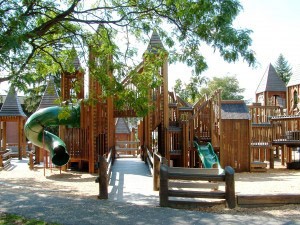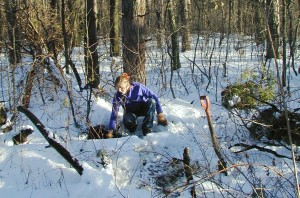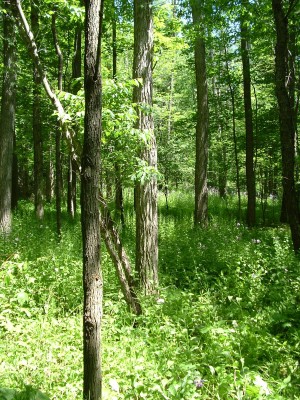
A Leathers and Associates playground, built in the
mid-1980's at Fall Creek Elementary School in Ithaca,
New York.
Starting in the early 1970s, the design firm of Leathers and Associates in Ithaca, New York, has been hugely successful designing playgrounds for schools and parks that were built by the local communities. Their fanciful designs featured towers, bridges, and tunnels, as well as the familiar swing sets and seesaws. What made these play structures so different, apart from community involvement in their construction, was that they were made mostly of wood. The aesthetic appeal of these new wooden playgrounds was seductive to many communities, and they soon became a common sight across the country.
Splinters? Not a problem: contact surfaces were finely sanded and polished to minimize the risk. Durability? Again, no problem in an age of new wood products designed to prolong the life of lumber exposed to the elements or in direct contact with the wet ground.
Yet there was a problem few recognized at the time. Widespread use of chemical preservatives in lumber for outdoor construction posed a health risk to those in direct contact with it. Most wood marketed for play structures, decks and patios, picnic tables, waterfront docks, and walkways was factory pressure-treated with a preservative compound containing high levels of cancer-causing arsenic.
By 2002, chromated copper arsenate (CCA), by far the most popular preservative in pressure-treated lumber, had become a high-profile environmental news story, mainly through concerns voiced by groups of parents and community leaders suddenly aware of a new public health threat. Tests found arsenic present at alarming levels on contact surfaces of play structures and decks as well as in the surrounding soil. Public concern for the safety of children exposed to arsenic while playing was matched by concern for workers who handle this lumber regularly and inhale its dust from saw cuts and sanding. More than a few carpenters used it only reluctantly, and then only with masks and other protective clothing.
After years of testing, risk assessment, and reevaluation of CCA, the U.S. Environmental Protection Agency (EPA) announced in December 2003 that it will no longer permit CCA products to be used for residential and public space construction. The agency stopped short of offering help in solving clean-up issues for tainted sites or local dumps saddled with discarded CCA-treated lumber.
Well before the EPA decision, Leathers and Associates, designers of so many wooden playground structures over the years, voluntarily discontinued use of CCA-treated lumber in its construction projects, turning instead to other, apparently less toxic, chemical treatments and to plastic wood compounds.
Pursuing alternatives to pressure-treated lumber now seems not just a worthy goal, but an imperative.

Dave Gell building a farmer’s market stand
made of weather-resistant black locust
Wood preservation has a simple rationale: most lumber exposed to rain and snow, or in direct contact with the ground or water, is vulnerable to rapid deterioration from fungus and insect attack. Chemical biocides can radically increase the wood’s longevity.
The lumber industry uses a pressure-treatment process in which chemicals are carried into the wood by a liquid under intense pressure. Whether the compound is creosote (as in railroad ties and telephone poles) or CCA and its modern relatives, the chemical works by killing the organisms that attack the wood. The lumber of choice for pressure treatment is southern yellow pine, as it absorbs the chemicals better than other woods. Chances are, if you built a deck or porch on your house any time between 1974 and 2004 and bought the wood for it from a standard lumberyard, you used yellow pine treated with CCA.
In addition to the health risks associated with direct contact with CCA-treated lumber, there are disposal problems. The reason arsenic turned up in soil tests near the playground structures in Ithaca and elsewhere is that it leached into the soil, something that has certainly occurred and will continue to occur in landfill sites. Burning CCA-treated lumber is discouraged, as arsenic concentration in the resulting ash would make it extremely toxic and expensive to remove. Just how to deal with the looming problem of CCA waste is now a topic for discussion in state and federal environmental agencies across the country.
With CCA no longer available for most construction and consumers still hungry for rot- and insect-resistant lumber, new EPA-approved chemical combinations have been developed for pressure treatment. Chief among these new compounds is ACQ or copper quat, a mixture of copper and a quaternary ammonium compound. As in CCA-treated lumber, ACQ acts as a biocide, though the chemicals are not as powerful and therefore not as effective as CCA. Quat is a fairly common compound found in disinfectants and cleaners. The EPA so far has no reason to question use of ACQ-treated lumber in most construction where the wood is in contact with the elements or in ground contact, but because it is toxic to marine life, ACQ is not recommended for freshwater or marine use. Finally, both the EPA and the lumber industry recommend that builders use the same precautions in handling the new material as they did with CCA (that is, wear protective gear and wash hands frequently).
ACQ pressure-treated southern yellow pine is now the industry standard for outdoor construction. Lacking arsenic, it is unquestionably a safer product than the old CCA and is more easily disposed of in landfills. Still, it is highly corrosive, as carpenters know who have ignored the recommendations and chosen not to use double-dipped galvanized or stainless steel nails and screws, only to see them eaten away. Anecdotal evidence of rashes and respiratory problems among builders and lumberyard workers tends to underscore the point that, as one yard worker in Auburn, New York, put it, “You have to know that, if they’re using so many chemicals to change the nature of the wood, you’d better be careful messing with it.”
The building materials industry has developed a recycled plastic lumber that effectively replaces pressure-treated wood in all but structural applications, but although it resembles wood, many people object to it because it just isn’t the real thing. Alternative organic treatments can prolong the life of lumber used in outdoor construction, but none can equal the durability of pressure-treated wood.
Generally lost in the industry’s pursuit of new materials to replace CCA pressure-treated lumber is serious consideration of alternative, untreated wood – wood with naturally occurring density, strength, and resistance to rot. American chestnut (sadly all but gone from northeastern forests), cedar, cypress, and redwood are all examples of tough trees with naturally rot-resistant woods. Cedar and chestnut, for example, for many years provided the lumber of choice for ground-contact construction in the Northeast. Some cedar fence posts sunk in the ground two generations ago are still serving their purpose today. Native cedar is available in some locales, but West Coast cedar and redwood are expensive substitutes.
Dave Gell of Trumansburg, in the Finger Lakes region of New York, has what he is confident is a better idea, an alternative to pressure-treated lumber that appeals to the naturalist and forest lover in all of us. A logger, woodworker, and environmentalist, Gell has for many years worked with black locust (Robinia pseudoacacia), seeking to persuade people that this fast-growing, sturdy, and naturally rot-resistant tree has most, if not all, of the characteristics we look for in construction typically made with pressure-treated lumber.

Jennifer Gell plants black locust seedlings in a clearing among
conifers. This nursery project is in a woodlot behind Interlaken
Elementary School in Interlaken, New York
Black locust occurs naturally in a range from Pennsylvania south along the Appalachians to Georgia and west into Arkansas and Missouri, though it has spread through cultivation as far west as California and as far east and north as southern Quebec. It grows as high as 80 feet, with a diameter of 2-3 feet. Its bark is iron-gray and, in older trees, deeply furrowed. Like other locusts, its leaves are pinnately compound with small, elliptical leaflets, giving the crown a delicate look at odds with the tough, sinewy trunk. In late spring, fragrant, drooping clusters of white flowers are aswarm with honeybees. The narrow, brown seed pods of black locust grow to 4 inches long and remain attached to the twigs during winter.
A pioneer species, black locust quickly takes advantage of disturbances such as fire and abandoned farm fields. It grows well in a variety of soil types but prospers best in drained limestone soil, making it ideal for most of New York state outside of the Adirondacks. Farmers in eighteenth-century New York brought black locust trees north for fence posts, windbreaks, and erosion control along streams, and the trees quickly established themselves throughout, now often in pure stands.
According to Rene H. Germain, a forester and an associate professor at the State University of New York College of Environmental Science and Forestry in Syracuse, black locust is a tree to take seriously. “Few, if any, trees come close to its wood property ratings in bending strength, compression, hardness, stiffness, and resistance to decay,” he said. “The only other northeastern species with rot-resistant characteristics that come close are the eastern redcedar and northern white-cedar. However, both rate poorly in bending strength, compression, hardness, and stiffness. Bottom line: no northeastern tree comes close to black locust for ground construction.”
The species’ durability comes largely from flavonoids and condensed tannins, chemicals that are produced naturally in the growth process and protect the tree from rot. Black locust lumber also shows a high degree of resistance to termite and carpenter ant infestations. Living trees, however, can be plagued by two pests in particular. Best known of these pests is the locust leaf-miner (Odontata dorsalis), which feeds on leaf tissue, turning the tree crown brown. In years of abundance, leaf-miners can defoliate trees, but they are generally not considered lethal. The black locust’s most dangerous enemy is the black locust borer (Megacyllene robiniae), the larvae of which tunnel their way into the wood, weakening the tree, and eventually exposing it to the ravages of a fungus transmitted by the borer. Germain sees the borer as “the biggest obstacle facing black locust management. It is not a trivial problem.”
One variant of Robinia, the rectissima or shipmast locust, is of particular interest to Dave Gell, who describes it as a “super-tree – everything the common black locust has, only more.” A native of Virginia, the tall and rigidly straight shipmast locust was imported to Long Island and the Hudson Valley. From there it has since spread to locations in central New York, notably the Finger Lakes region. The tree was not, in fact, used for ship masts but for ribs and planking, where the hardness of the wood gave it an advantage even over traditional oak. Commonly reaching 100 feet, its size and straightness make it an excellent timber tree, yielding more useable board feet than standard black locust.
Gell started the Black Locust Initiative (BLI) in 1996 in response to a local teacher’s proposal that schoolchildren learn skills in arithmetic, graphing, biology, and general ecology principles through hands-on work in the woods. Since then, the BLI has established regular programs and workshops that introduce people of all ages to forestry and forest management techniques, with black locust as the focal point.
Pacing around a paper-crowded table outside his modest home in the middle of a dense woodlot, Gell ticked off the main reasons he has become interested in promoting shipmast locust as a tree ripe for timber management:
Gell and BLI volunteers have been working out the best method for propagating the shipmast locust, which normally doesn’t produce seed pods. The shipmast locust, even more than regular black locust, is a root-sprouter, so making selective root cuttings that contain adventitious buds is the best way to go. The samples, taken from genetically superior trees, are carefully gathered and stored, then planted in prepared clearings amid other woodlot species. Gell does not believe in monoculture row plantations like those in Hungary, for example, where black locust growing stock imported from America has become a major timber tree. Instead, his vision for the future of shipmast locust is to grow it in a diversified forest culture.

A shipmast locust and its offspring
“You can do the row planting, but you’re sure not going to get as good lumber,” he said. Then, pointing to his chickens rooting around in the leaf litter at his feet, he added, “You can put chickens in cages. The thing is that trees like to be in a forest.”
One idea Gell is actively pursuing these days is turning acres of conifer plantations in the Finger Lakes into nurseries for shipmast locust and other hardwood species. The plantations were created in the late 1920s and early 1930s as part of a state-government plan to reclaim old agricultural land for timber production and watershed protection. Now the rows of mature spruce and pine stand largely abandoned, not worth the cost of harvesting. As nursery sites for fast-growing trees like shipmast locust and catalpa, mixed with slower hardwoods like red oak and white oak, Gell believes these plantation could evolve into healthy, diverse forests with trees of different growth stages that are harvested in a sort of crop rotation. He calls this approach to growing and managing timber “progressive forestry,” and he spent part of 2004 working with a group of students on just such a nursery site in the Finger Lakes. Funding for this pioneer project came from a Sustainable Agricultural Research and Education grant from the U.S. Department of Agriculture.
“The biomass is already there, and thermal and moisture issues have already been solved for good growing conditions on healthy soil,” Gell explains. “It’s a low-value timber site at the moment, so a cost-benefit analysis favors using these forests as nursery places for a more valuable timber tree.”
But Gell is not concerned with timber industry economics in any numbers-crunching sense. Rather, the economic calculus of the BLI focuses more on the value of environmental stewardship and community needs. The BLI has even developed an invoice for their projects that contains a bottom line for “green accounting,” a measure of environmental benefits offsetting the dollar value of the work done.
To Gell, his most important work is reaching out to children who will be future stewards of the forests. BLI board member Carl Leopold, son of pioneering ecologist Aldo Leopold and himself a passionate environmentalist, has been an admirer of Gell’s for many years. “The big promise of the initiative is that it reaches kids, and they get just taken away by the great fun of it all,” he said. “Dave Gell has a lot of support from the schools in the community, and it’s just great that the kids can learn in such a constructive and ecologically sensitive environment.”
“You might have a kid in the fourth grade who plants a black locust with his class,” Gell mused. “In 30 years it’s going to be a 70-foot timber tree. He can say later, when he’s a member of the school board or a parent of school-aged kids, that he planted that tree that they can now use to build a playground. It’s a tree that can bridge the generations.”
It’s also a tree that may eventually provide a natural alternative to toxic pressure-treated lumber. Whether or not it will be grown in industrial quantities has yet to be seen, but the first steps toward that goal have been taken.


Discussion *